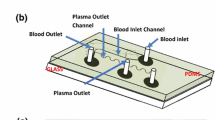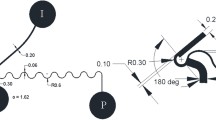Abstract
The separation of red blood cells from plasma flowing in microchannels is possible by biophysical effects such as the Zweifach–Fung bifurcation law. In the present study, daughter channels are placed alongside a main channel such that cells and plasma are collected separately. The device is aimed to be a versatile but yet very simple module producing high-speed and high-efficiency plasma separation. The resulting lab-on-a-chip is manufactured using biocompatible materials. Purity efficiency is measured for mussel and human blood suspensions as different parameters, such as flow rate and geometries of the parent and daughter channels are varied. The issues of blood plasma separation at the microscale are discussed in relation to the different regimes of flow. Results are compared with those obtained by other researchers in the field of micro-separation of blood.






Similar content being viewed by others
References
Abkarian M, Viallat A (2005) Dynamics of vesicles in a wall-bounded shear flow. Biophys J 89(2):1055–1066
Abkarian M, Viallat A (2008) Vesicles and red blood cells in shear flow. Soft Matter 4:653–657
Abkarian M, Faivre M, Viallat A (2007) Swinging of red blood cells under shear flow. Phys Rev Lett 98(18):188302
Al-Soud WA, Rådström P (2001) Purification and characterization of PCR-inhibitory components in blood cells. J Clin Microbiol 39:485–493
Al-Soud WA, Jönsson LJ, Rådström P (2000) Identification and characterization of immunoglobulin G in blood as a major inhibitor of diagnostic PCR. J Clin Microbiol 38:345–350
Blattert C, Jurischka R, Tahhan I, Schoth A, Kerth P, Menz W (2004) Separation of blood cells and plasma in microchannel bend structures. In: Proceedings of eighth international conference on miniaturized systems for chemistry and life sciences, pp 483–485
Brenner T, Haeberle S, Zengerle R, Ducree J (2004). Continuous centrifugal separation of whole blood on a disk. In: Proceedings of eighth international conference on miniaturized systems for chemistry and life sciences, pp 566–568
Chien S, Tvetenstrand CD, Epstein MAF, Schmidschonbein GW (1985) Am J Physiol 248:H568–H576
Epigem Ltd, www.epigem.co.uk, last accessed 19 April 2009
Faivre M, Abkarian M, Bickraj K, Howard S (2006) Geometrical focusing of cells in a microfluidic device: an approach to separate blood plasma. Biorheology 43:147–159
Fung YC (2004) Biomechanics, 2nd edn. Springer, New York
Jaggi RD, Sandoz R, Effenhauser CS (2007) Microfluidic depletion of red blood cells from whole blood in high-aspect-ratio microchannels. Micro NanoFluid 3:47–53
Kaloyiannia M, Dailianisa MS, Chrisikopouloua E, Zannoua A, Koutsogiannakia S, Alamdarib DH, Koliakosb G, Dimitriadisc VK (2009) Oxidative effects of inorganic and organic contaminants on haemolymph of mussels. Comp Biochem Physiol C (in press)
Kersaudy-Kerhoas M, Dhariwal RS, Desmulliez MPY (2008) Recent advances in microparticle continuous separation. IET Nanotechnobiol 1:1–13
Olla P (1997) The lift on a tank-treading ellipsoidal cell in a shear flow. J Phys II 7(10):1533–1540
Pamme N (2007) Continuous flow separations in microfluidic devices. Lab Chip 7:1644–1659
Pries AR, Secomb TW, Gaehtgens P (1996) Biophysical aspects of blood flow in the microvasculature. Cardiovasc Res 32:654–667
Roberts BW, Olbricht WL (2006) The distribution of freely suspended particles at microfluidic bifurcations. AIChE J 52:199–206
Sallam AM (1984) Human red blood-cell hemolysis in a turbulent shear-flow—contribution of Reynolds shear stresses. Biorheology 21:783–797
Yang S, Undar A, Zahn JD (2006) A Microfluidic device for continuous, real time blood plasma separation. Lab Chip 6:871–880
Zorita I, Apraiz I, Ortiz-Zarragoitia M, Orbea A, Cancio I, Soto M, Marigomez I, Cajaraville MP (2007) Assessment of biological effects of environmental pollution along the NW Mediterranean Sea using mussels as sentinel organisms. Environ Pollut 148:236–250
Zorita I, Ortiz-Zarragoitiaa M, Apraiza I, Cancioa I, Orbeaa A, Sotoa M, Marigómeza I, Cajaraville MP (2008) Assessment of biological effects of environmental pollution along the NW Mediterranean Sea using red mullets as sentinel organisms. Environ Pollut 153(1):157–168
Acknowledgments
The authors acknowledge the financial support of the Engineering and Physical Science Research Council (EPSRC) through the funding of the Grand Challenge Project ‘3D-Mintegration’, reference EP/C534212/1. We thank Tim Ryan and Phil Summersgill, Epigem Ltd. for the fabrication of the chips. The fabrication work was carried out in the Fluence Microfluidics Application Centre supported by the Technology Strategy Board (TSB) and the OneNE Regional Development Agency as part of the UK’s MNT Network. The authors thank Deirdre Kavanagh for careful reading of the manuscript.
Author information
Authors and Affiliations
Corresponding author
Rights and permissions
About this article
Cite this article
Kersaudy-Kerhoas, M., Dhariwal, R., Desmulliez, M.P.Y. et al. Hydrodynamic blood plasma separation in microfluidic channels. Microfluid Nanofluid 8, 105–114 (2010). https://doi.org/10.1007/s10404-009-0450-5
Received:
Accepted:
Published:
Issue Date:
DOI: https://doi.org/10.1007/s10404-009-0450-5




